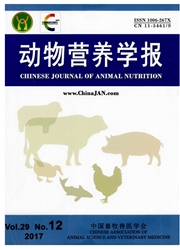

 中文摘要:
中文摘要:
本试验旨在研究饲料中镁添加量对中华绒螯蟹幼蟹生长、体成分及抗氧化能力的影响。在基础饲料中分别添加0、1.5、3.0、4.5、6.0和7.5 g/kg镁( L-天门冬氨酸镁形式),制成镁含量实测值分别为0.98、1.43、3.40、4.79、6.65和7.98 g/kg的6种试验饲料。选取平均体重为(2.97±0.01) g的中华绒螯蟹幼蟹900只,随机分为6个组,每组5个重复,每个重复30只幼蟹。每组幼蟹随机投喂1种试验饲料,试验期为10周。结果表明:添加3.0 g/kg镁组幼蟹的增重率、存活率和全蟹粗蛋白质含量最高,但各组间差异不显著( P〉0.05)。幼蟹日摄食率、饲料系数及全蟹粗脂肪、水分和粗灰分含量各组之间亦无显著差异( P〉0.05)。全蟹中镁含量随着饲料中镁添加量的升高而升高,而钙含量则在未添加镁组最高,导致此组的钙镁比最高。幼蟹肝胰腺和血清中还原型谷胱甘肽( GSH )含量随着饲料中镁添加量的升高先升高后降低,在添加3.0 g/kg镁组达到最高值,其肝胰腺中GSH含量显著高于添加7.5 g/kg镁组( P〈0.05),血清中GSH含量显著高于未添加镁组( P〈0.05);血清和肝胰腺中丙二醛( MDA)含量则随着饲料中镁添加量的升高先降低后升高,在添加3.0 g/kg镁组获得最低值,显著低于其他各组( P〈0.05)。由此得出,以L-天门冬氨酸镁为镁源,当饲料中镁添加量为3.0~4.5 g/kg时中华绒螯蟹幼蟹的生长效果较好;以肝胰腺中GSH含量为判据,采用二次回归模型进行拟合发现,当饲料中镁添加量为3.76 g/kg(饲料中镁含量为4.39 g/kg)时,中华绒螯蟹幼蟹的抗氧化能力最佳。
 英文摘要:
英文摘要:
This experiment was conducted to study the effects of magnesium ( Mg ) supplementation on growth, body composition and antioxidant ability of juvenile Chinese mitten crab ( Eriocheir sinensis) . Six experimental diets were formulated with basal diet added of Mg ( the form of L-aspartic acid magnesium) of 0, 1.5, 3.0, 4.5, 6. 0 and 7. 5 g/kg, and the measured values of dietary Mg content were 0. 98, 1. 43, 3. 40, 4.79, 6.65 and 7. 98 g/kg, respectively. A total of 900 juvenile Chinese mitten crab with the average body weight of (2.97±0.01) g were randomly allocated to 6 groups with 5 replicates per group and 30 crab per replicate, and each group was randomly fed one of six experimental diets for 10 weeks. The results showed as follows: the highest values of weight gain rate, survival ratio and crude protein content in whole-body were all found in the group with the Mg supplementation of 3.0 g/kg, but no significant differences in those indices among all groups ( P〉0.05) . There were also no significant differences in the daily feeding rate, feed conversion ratio, and the contents of moisture, crude lipid and ash in whole-body among all groups ( P〉0.05) . The Mg content in whole-body was increased with the Mg supplementation increasing, while the highest value of calcium ( Ca) content in whole-body was appeared in the group without Mg supplementation, which lead to this group had the highest value of Ca/Mg in whole-body. The content of reduced glutathione ( GSH) in hepa-topancreas and serum was firstly increased and then decreased with the increase of dietary Mg supplementation, and the highest values were all found in the group with the Mg supplementation of 3.0 g/kg. The GSH content in hepatopancreas and serum in the group with the Mg supplementation of 3. 0 g/kg was significantly higher than that in the group with the Mg supplementation of 7.5 g/kg and the group without Mg supplementation, re-spectively (P〈0.05). The content of malonaldehyde (MDA) in hepatopancrea
 同期刊论文项目
同期刊论文项目
 同项目期刊论文
同项目期刊论文
 Growth performance, antioxidant status and immune response in darkbarbel catfish Pelteobagrus vachel
Growth performance, antioxidant status and immune response in darkbarbel catfish Pelteobagrus vachel Partial or complete substitution of fish meal with soybean meal and cottonseed meal in Chinese mitte
Partial or complete substitution of fish meal with soybean meal and cottonseed meal in Chinese mitte Partial or Total Replacement of Soybean Meal by Cottonseed Meal in Practical Diets for Chinese Mitte
Partial or Total Replacement of Soybean Meal by Cottonseed Meal in Practical Diets for Chinese Mitte Dietary vitamin B-12 requirement and its effect on non-specific immunity and disease resistance in j
Dietary vitamin B-12 requirement and its effect on non-specific immunity and disease resistance in j Effect of dietary copper on the growth performance, non-specific immunity and resistance to Aeromona
Effect of dietary copper on the growth performance, non-specific immunity and resistance to Aeromona Molecular cloning, characterization and mRNA expression of copper-binding protein hemocyanin subunit
Molecular cloning, characterization and mRNA expression of copper-binding protein hemocyanin subunit Effects of ammonia stress, dietary linseed oil and Edwardsiella ictaluri challenge on juvenile darkb
Effects of ammonia stress, dietary linseed oil and Edwardsiella ictaluri challenge on juvenile darkb Molecular characterization of cathepsin L cDNA and its expression during oogenesis and embryogenesis
Molecular characterization of cathepsin L cDNA and its expression during oogenesis and embryogenesis EFFECT OF COPPER-ENRICHED ARTEMIA ON GROWTH, BODY COMPOSITION, ANTIOXIDANT ENZYME ACTIVITIES, AND OS
EFFECT OF COPPER-ENRICHED ARTEMIA ON GROWTH, BODY COMPOSITION, ANTIOXIDANT ENZYME ACTIVITIES, AND OS Effect of oxidized fish oil and α-tocopherol on growth, antioxidation status, serum immune enzyme ac
Effect of oxidized fish oil and α-tocopherol on growth, antioxidation status, serum immune enzyme ac Effects of dietary folic acid on growth, antioxidant capacity, non-specific immune response and dise
Effects of dietary folic acid on growth, antioxidant capacity, non-specific immune response and dise Molecular characterization of a cytosolic manganese superoxide dismutase from the Chinese mitten cra
Molecular characterization of a cytosolic manganese superoxide dismutase from the Chinese mitten cra Effect of dietary lipids and vitamin E on growth performance, body composition, anti-oxidative abili
Effect of dietary lipids and vitamin E on growth performance, body composition, anti-oxidative abili Growth and immune response of Chinese mitten crab (Eriocheir sinensis) fed diets containing differen
Growth and immune response of Chinese mitten crab (Eriocheir sinensis) fed diets containing differen 期刊信息
期刊信息
